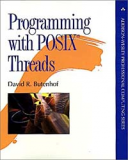Книга: Programming with POSIX® Threads
1.2.6 Concurrency control functions
1.2.6 Concurrency control functions
Any "concurrent system" must provide a core set of essential functions that you need to create concurrent execution contexts, and control how they operate within your library or application. Here are three essential facilities, or aspects, of any concurrent system:
1. Execution context is the state of a concurrent entity. A concurrent system must provide a way to create and delete execution contexts, and maintain their state independently. It must be able to save the state of one context and dispatch to another at various times, for example, when one needs to wait for an external event. It must be able to continue a context from the point where it last executed, with the same register contents, at a later time.
2. Scheduling determines which context (or set of contexts) should execute at any given point in time, and switches between contexts when necessary.
3. Synchronization provides mechanisms for concurrent execution contexts to coordinate their use of shared resources. We use this term in a way that is nearly the opposite of the standard dictionary meaning. You'll find a definition much like "cause to occur at the same time," whereas we usually mean something that might better be expressed as "prevent from occurring at the same time." In a thesaurus, you may find that "cooperate" is a synonym for "synchronize"-and synchronization is the mechanism by which threads cooperate to accomplish a task. This book will use the term "synchronization," though, because that is what you'll see used, almost universally.
There are many ways to provide each of these facilities—but they are always present in some form. The particular choices presented in this book are dictated by the book's subject—Pthreads. Table 1.1 shows a few examples of the three facilities in various systems.
| Execution context | Scheduling | Synchronization | |
| Real traffic | automobile | traffic lights and signs | turn signals and brake lights |
| UNIX | process | priority (nice) | wait and pipes |
| (before threads) | |||
| Pthreads | thread | policy, priority | condition variables and mutexes |
TABLE 1.1 Execution contexts, schedulers, and synchronization
A system's scheduling facility may allow each thread to run until it voluntarily yields the processor to another thread ("run until block"). It may provide time-slicing, where each thread is forced to periodically yield so that other threads may run ("round-robin"). It may provide various scheduling policies that allow the application to control how each thread is scheduled according to that thread's function. It may provide a "class scheduler" where dependencies between threads are described so that, for example, the scheduler can ensure that members of a tightly coupled parallel algorithm are scheduled at the same time.
Synchronization may be provided using a wide variety of mechanisms. Some of the most common forms are mutexes, condition variables, semaphores, and events. You may also use message passing mechanisms, such as UNIX pipes, sockets, POSIX message queues, or other protocols for communicating between asynchronous processes—on the same system or across a network. Any form of communication protocol contains some form of synchronization, because passing data around with no synchronization results in chaos, not communication.
The terms thread, mutex, and condition variable are the main topics of this book. For now, it is enough to know that a thread represents an "executable thing" on your computer. A mutex provides a mechanism to prevent threads from colliding unexpectedly, and a condition variable allows a thread, once it has avoided such a collision, to wait until it is safe to proceed. Both mutexes and condition variables are used to synchronize the operation of threads.
- 1.2.2 Concurrency
- Introduction to Microprocessors and Microcontrollers
- Data sending and control session
- Data Binding Using the GridView Control
- Configure Access Control
- Using the kill Command to Control Processes
- 3.4.4. Concurrency Control
- CHAPTER 4 Functions and Libraries in mikroC
- Controlling Services at Boot with Administrative Tools
- Basic Shell Control
- Using Priority Scheduling and Control
- Controlling Apache with Fedora's service Command




